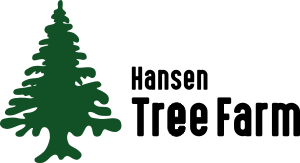
Trees & Prices
Trees
White, Norway pines
Blue, Meyer spruces
Balsam, Fraser, Canaan firs $150
Full service:
- We provide a saw
- We shake & bale your tree
- We'll tie your tree on vehicle
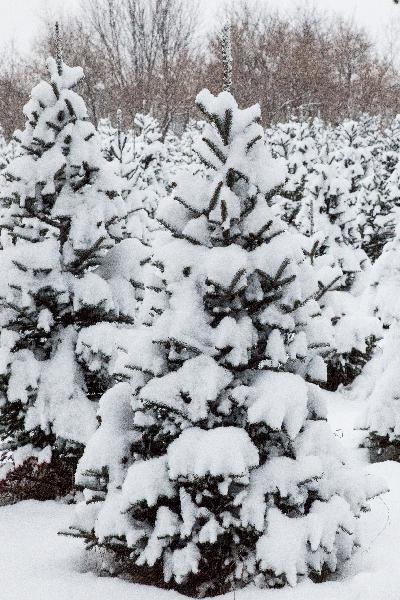
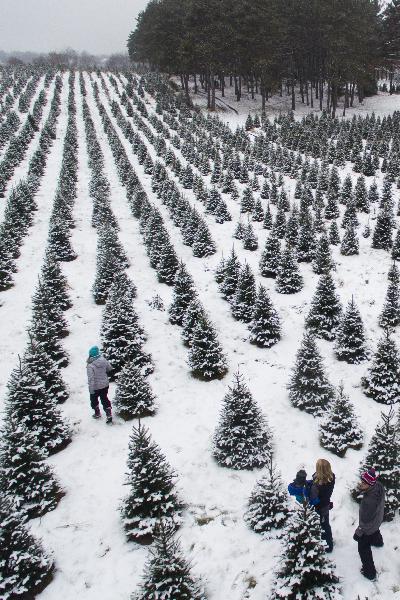
FULL SERVICE
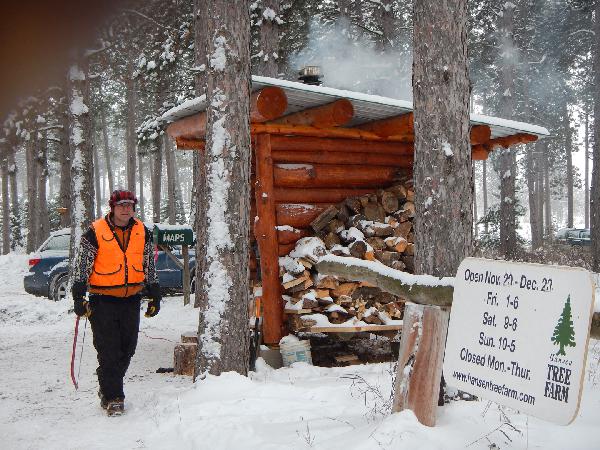
Welcome to Hansen Tree Farm!
When you arrive you’ll receive:
- Map to navigate our farm
- Saw to cut your tree, or
- Parking by our pre-cut area
- Answers to your questions
- Photo guide to tree species, if you need
- The perfect distancing experience!
- Map to navigate our farm - Click here
When you arrive you’ll receive:
- Map to navigate our farm
- Saw to cut your tree, or
- Parking by our pre-cut area
- Answers to your questions
- Photo guide to tree species, if you need
- The perfect distancing experience!
- Map to navigate our farm - Click here
Many trees are now pruned at the base by Mark to make it easier for you to cut. This also gives you a more accurate idea of what the tree will look like when it’s in a stand at home
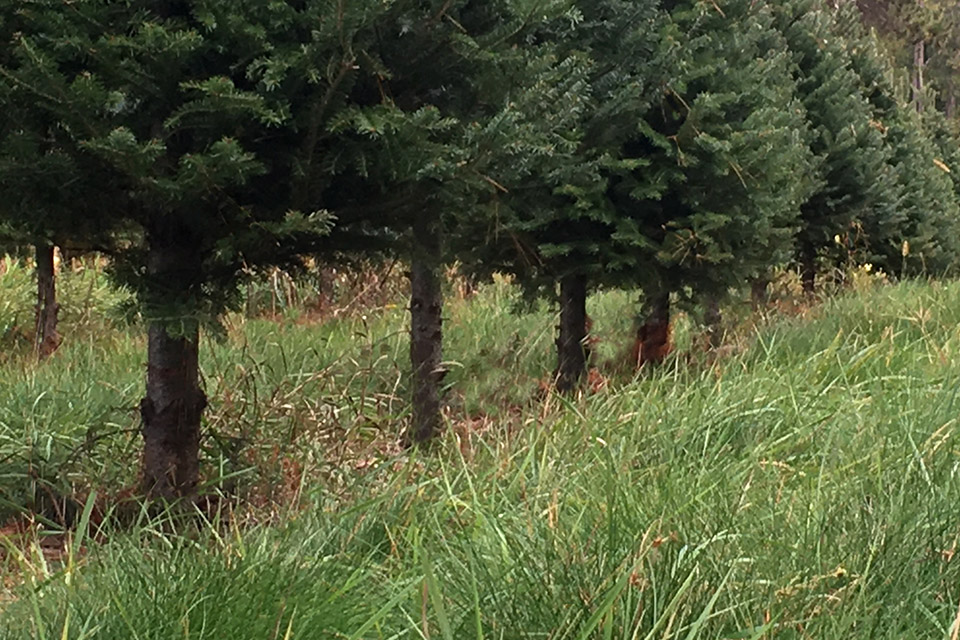
Signs by every field identify the species. And there’s parking next to every block of trees
We’re here to help!
Need help cutting or carrying your tree?
Selecting a pre-cut?
Finding extra, and free, boughs?
Just ask anyone in an orange vest!
Need help cutting or carrying your tree?
Selecting a pre-cut?
Finding extra, and free, boughs?
Just ask anyone in an orange vest!
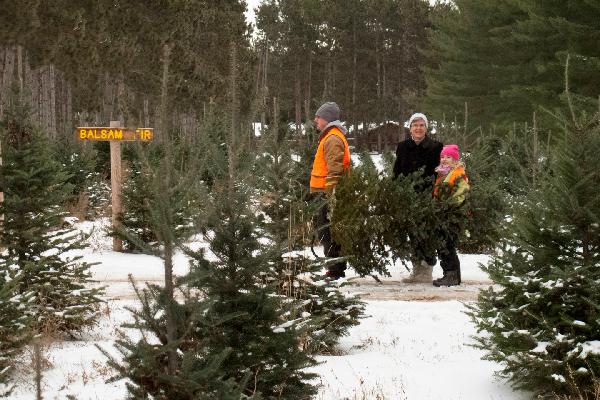
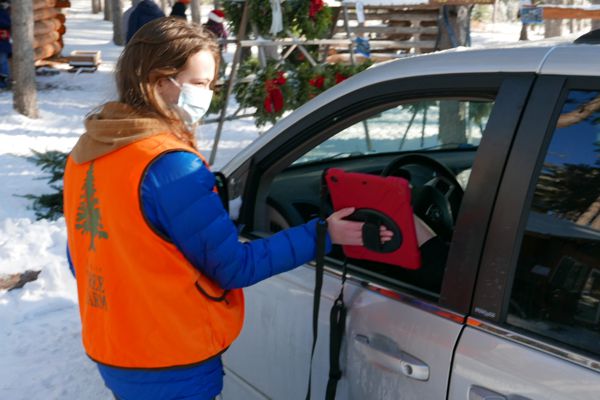
After cutting your tree, balance it on top of your vehicle and drive to either of the two checkouts. From your car, pay a cashier or on-line. Watch as your tree is shaken, baled and tied on to your vehicle. And, if you haven’t already, have a free cocoa or cider (outside) and a Christmas sausage or hot dog (in gift shop). And, be sure to enjoy a hay-ride during your visit with us.
After you’ve paid for your tree we’ll be busy shaking your tree to remove dust or grass and old needles. Leave them here, not in your home!

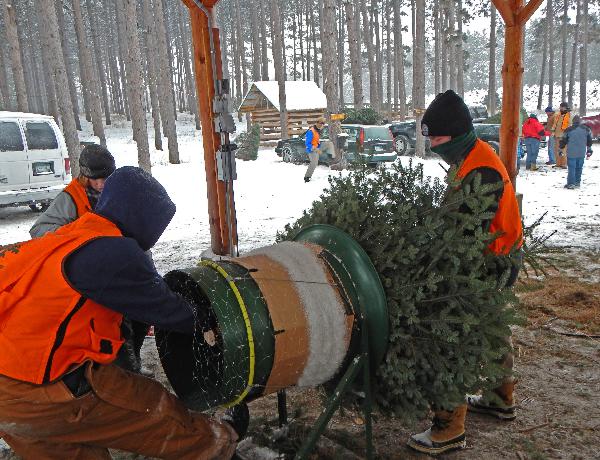
After shaking we’ll bale your tree, making it easier to transport and for you to carry inside your home. If you have a “spike” tree stand remember to ask us to drill your tree before we tie it on your car!
Finally, we securely load and tie your tree. We use heavy duty, natural sisal twine. Our goal is to make your outing simple and easy. We hope you enjoy our farm as much as we do!

PRICE PHILOSOPHY
We don’t price our trees by height or species. Our one price for any tree includes our full service and all the activities we offer. It also acknowledges that much of our work, investment, overhead and risk is the same in a 5’ tree as an 8’ one, plus our festive atmosphere. All our fields are clearly identified with signs to indicate the species. If you don't remember your favorite type, the photos and descriptions below should help you decide. We feel that a set price is simpler and more fair than selling ‘by the foot’ because it also includes all of the activities. Please, just come and enjoy your day!
PLENTY OF TREES
Our scenic 40-acre farm has trees from 5’ to 10’ tall. When you arrive we’ll give you a map of all our fields. If you’d like a preview of the map scroll to the bottom of this page.
• 4,500 balsam fir
• 700 Fraser fir
• 1,000 Canaan fir
• 1,750 blue & Meyer spruce
• 1,200 white pine
• 50 Norway (red) pine
• 700 Fraser fir
• 1,000 Canaan fir
• 1,750 blue & Meyer spruce
• 1,200 white pine
• 50 Norway (red) pine
PRE-CUT
Pre-cut balsam pines and spruces are also available. They are priced per-foot and adjustments made for quality. Prices range from $75 to $250 for sizes from 5’ to 12’. About half of these trees come from our farm and are cut during the week as demand dictates. The others, primarily the larger balsam firs, are from another farm further north and are cut just before Thanksgiving. If you select a pre-cut tree we’ll make a fresh cut before we tie it onto your vehicle.
UNSHEARED
A hundred or more un-sheared (some say ‘natural’ or ‘Charlie Brown’) balsam fir grow under the canopy of our forest. They range from 10’ to 20’ tall and are very sparse with a true layered look. While not for everyone, their type is traditional in northern Europe.
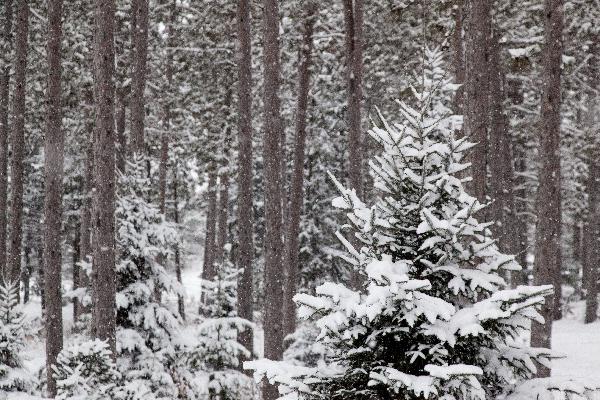
Tree Species
Balsam Fir


Close-up views of firs show the top and underside color of needles.
Balsam fir is the most popular Christmas tree in Minnesota. It’s also our favorite and so we have more fields of balsam than all other species combined. It has soft needles about one inch long, a pleasant fragrance, and needles that hold tight for a long time. Space between branches leaves room to place ornaments and lights. Balsams are the only fir species native to the Great Lakes area, and all the way to the New England states and Maritime Provinces. For that reason, ecologically it is our preferred variety and we encourage you to consider it over the Fraser fir. The seed source for our balsams comes from Maine. We like that it produces needles all around the stem (as opposed to a flat pattern) and that the underside of the needles is lighter than the top. University of Minnesota forest ecology professor Henry Hansen, who started Hansen Tree Farm, coauthored "Balsam Fir," the 1965 reference and textbook.

Balsam Fir
Fraser Fir


Close-up views of firs show the top and underside color of needles.
Frasers have similar qualities to Balsam fir, with the exception that the under side of Fraser needles has a silvery – or lighter – color. They also have a heavier, thicker trunk. Fraser firs are native to the mountains of Virginia, North Carolina and eastern Tennessee. They evolved from balsam fir following the glaciers. Their native range at 4-6,000 foot elevation gets about 80 inches of rain per year, and that is what it takes for them to look their best. But since central Minnesota receives about 25 inches of precipitation growers must either irrigate a lot or settle for an inferior/stressed tree. We encourage you to compare a Fraser with a native balsam fir, most people can’t tell the difference!
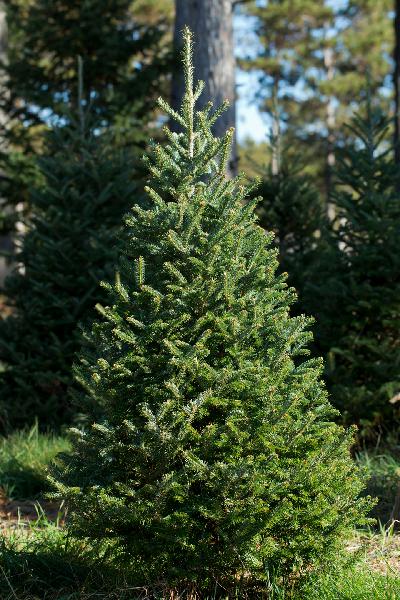
Fraser Fir
Canaan Fir
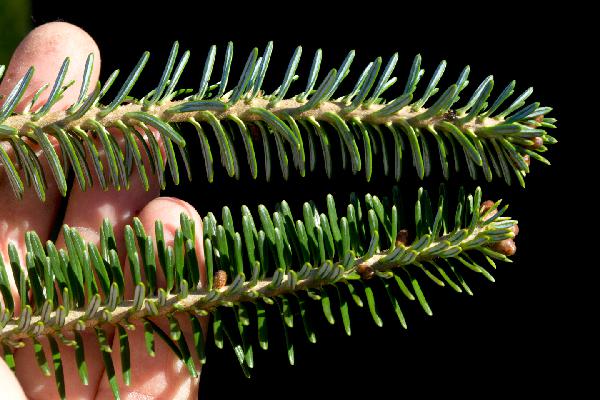

Close-up views of firs show the top and underside color of needles.
Canaan fir is technically not a unique variety, but an ‘ecotype’. It is named because it originated, following the retreat of the glaciers, in the Canaan Valley of West Virginia, at and above 3,000 feet elevation where freezing temperatures persisted late into spring. Its primary difference -- from Fraser and balsam firs -- is that it emerges from winter dormancy two to three weeks later than the other firs. This makes it suitable for ‘frost pockets’, or low areas that are susceptible to late frosts when heavy cool air settles in on a still spring night and kills new growth. We have planted it in two of these low areas on our farm. Its appearance is between Balsam and Fraser firs, since it evolved from balsam.
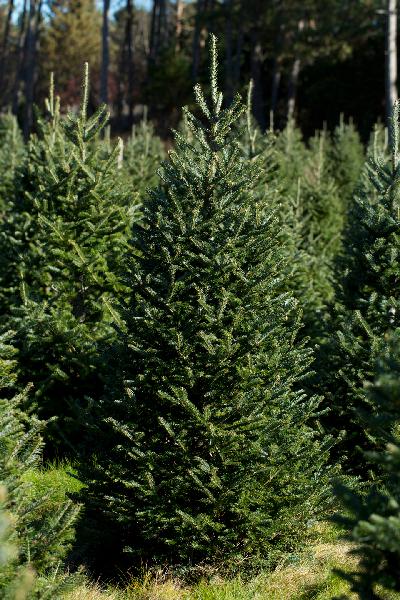
Canaan Fir
White Pine
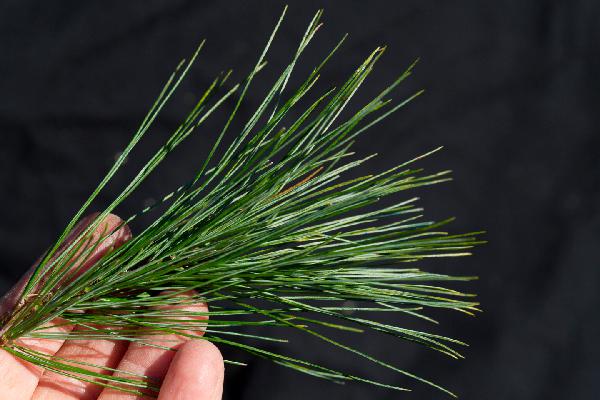

This graceful tree has long, 6-inch needles that are soft to the touch. The branches are also pliable and do not hold heavy ornaments, but small lights and decorations are perfect for the limber branches. A nicely sheared white pine appears full, with no openings. It looks nice even when small, which can’t be said about other pines. All pines tend to grow wider, compared with firs.
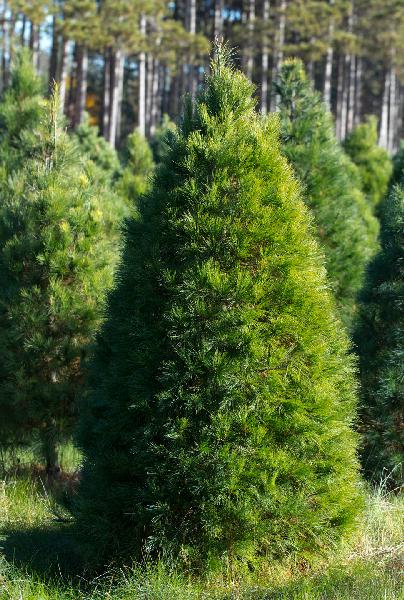
White Pine
Red Pine
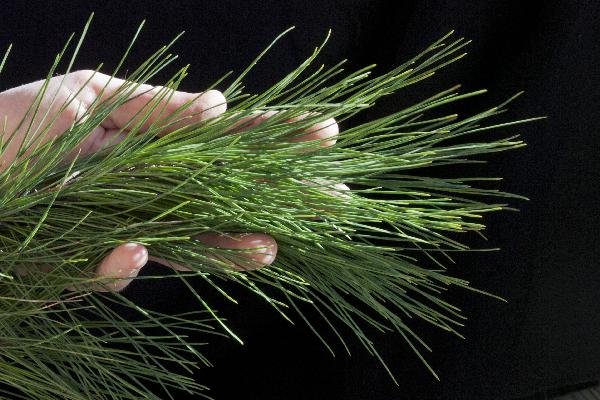

Our state tree, also known as Norway pine, has very long (6-inch) needles and stiff, course branches. This species is difficult to shape -- by pruning -- into an indoor Christmas tree. There will always be a few openings, which can be used to hang larger ornaments. It is a traditional tree that was popular in the 1950s and 60s, and was the species used when ‘flocking’ was the fad. Our red/Norway pines usually take first place at the State Fair.
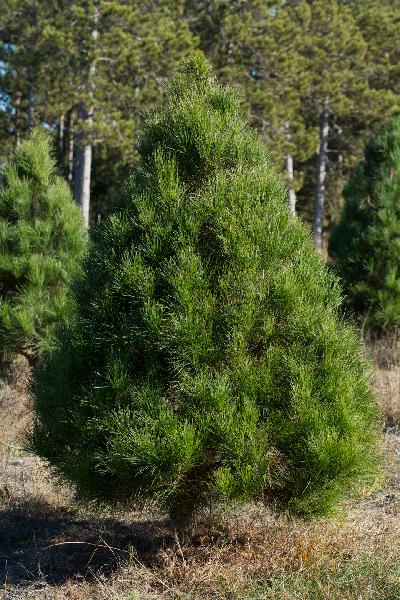
Red Pine
Colorado Blue Spruce
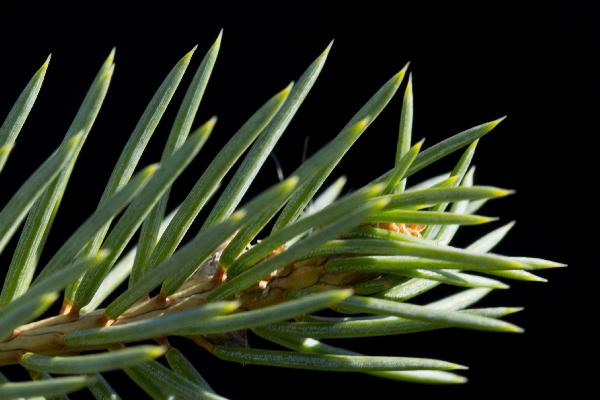

Short needles and stiff, flat branches make the symmetrical blue spruce easy to identify. The perfectly layered branches are nicely spaced for decorating, and the stiff branches support even heavy ornaments. You can see from the close-up photo that the needles are very sharp and will deter pets from playing with -- or climbing -- the tree. When you decorate a blue spruce wear gloves to prevent scratching your hands! Since the spruce family holds it needles the shortest length of time, we recommend it not be cut before Thanksgiving. Old timers call spruces ‘30-day’ trees. But, kept watered it will last from Thanksgiving to New Year’s.

Colorado Blue Spruce
For more detail on types of trees, visit mncta.com

